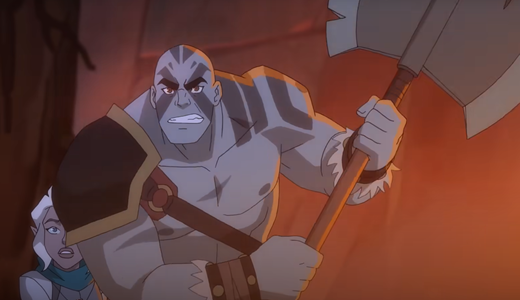LISTEN TO THE PLUGGED IN SHOW, EPISODE 116
Violence—at least violence in movies—comes in many forms. It can be graphically realistic in war pics, slapstick crazy in comedies, curiously graceful in martial arts flicks and outrageously goopy in horror movies. As parents, we sometimes give a pass to certain types of violence and put a hard stop on others.
But why? Where are the lines? Is the sort of “painless” violence we see in, say, Tom & Jerry cartoons really “better” than more realistic violence—the sort of violence that comes with consequences?
We talked about that in a blog previously published, of course. But we take an even deeper dive in our podcast, and hopefully give you a few tips and tools you can use in your own home.
And speaking of violence, we then turn our attention to The Legend of Vox Machina—a new animated series on Amazon Prime. It’s based on Critical Role, an online show/podcast wherein a bunch of voice actors play Dungeons and Dragons. But this animated iteration takes a seriously bloody turn.
You can expect all this and more when you listen to this week’s show. And after you listen, you can chime in with your own violent thoughts on Facebook, Instagram or even via email ([email protected]). Go ahead, knock yourself out.
Additional Resources:
- Gift of Any Amount Offer: 7 Traits of Effective Parenting by Dr. Daniel Huerta
- Plugged In Blog: “Plugged In Talks Content: Positive Elements”
- Plugged In Blog: “Plugged In Talks Content: Spiritual Elements”
- Plugged In Blog: “Plugged In Talks Content: Sexual Content”
- Plugged In Blog: “Plugged In Talks Content: Violence”
- Plugged In Blog: “Plugged In Talks Content: Crude or Profane Language”
- Plugged In Blog: “Plugged In Talks Content: Drug and Alcohol Content”
- Plugged In Blog: “Plugged In Talks Content: Other Negative Elements”
- Plugged In Show Episode 115: “The Winter of Our … Content, and Belle!” https://www.pluggedin.com/blog/the-plugged-in-show-episode-115/
- Plugged In Review: Saving Private Ryan
- Plugged In Review: Halloween (2018)
- Plugged In Review: Nightmare on Elm Street (2010)
- Plugged In Review: Saw
- Plugged In Review: Hacksaw Ridge
- Plugged In Review: Spiral
- Plugged In Review: The Matrix
- Plugged In Review: The Passion of the Christ
- Plugged In Review: Kill Bill Vol. 1
- Plugged In Review: Shang Chi and the Legend of the Ten Rings
- Plugged In Show Episode 93: “A Look at Shang Chi and Exploring the Metaverse”
- Plugged In Review: The Karate Kid
- Plugged In Review: Cobra Kai
- Plugged In Review: The Legend of Vox Machina
- Plugged In Review: Critical Role
- Plugged In Review: The Witcher: Nightmare of the Wolf
- Plugged In Review: Castlevania
- Plugged In Review: Avatar: The Last Airbender







One Response
-I think about this a lot since violent content has perennially been controversial over the years, though this has often felt more like a distraction (“focus on video games and Hollywood instead of violent foreign and domestic policy”) or a half-truth (“focus on level of intense detail”).
Yes, gory violence can traumatize, but so can “slapstick” or emotional drama for sensitive viewers (one of my relatives was deeply upset by Tom & Jerry as a young child; for another friend, this was “Yu-Gi-Oh” instead, which felt like its dub was only barely made child-appropriate, and inconsistently at that).
Likewise, for media where viewer choices affect the outcome of the story, most notably video games but also some television shows and books, I think it’s worth talking about violence in terms of context even when the depiction thereof isn’t very graphic — Paradox’s strategy games, similar to Imperator: Rome, which Focus reviewed here https://www.pluggedin.com/game-reviews/imperator-rome/ , often present violence, conquest, and even demographic extermination as a spreadsheet, so it’s usually not intense to witness but can carry a great deal of personal weight if the player allows that, to say nothing of allowing many kinds of “pop-culture-unsavory” violence (including genocide).